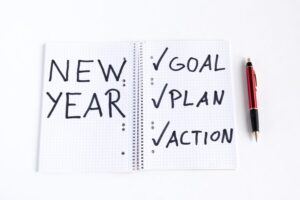Did you know that the failure rate of New Year’s Resolutions is estimated to be 80%?! Most people lose their motivation by the end of January at the earliest or mid-February at the latest.
Warren Holleman, who has a Ph.D. in Behavioral Science, says, “It takes a lot more than a resolution to change. It takes a self-understanding, skills, strategies, and support.” Rather than create a simple, yet daunting, list of resolutions, choose one or two things to focus on. Then, strategize. Break each goal into achievable tasks. 
For instance, if your goal is to exercise more. The first thing to do is figure out what ‘exercising more’ means to you. Say you’ve taken a break from exercising for the last few years. It doesn’t make sense to immediately expect yourself to work out 5 days a week. Instead, create an action plan where you gradually build up the amount of exercise you do. Try to find a friend to workout with or choose activities that feel less like exercise and more like fun; try hiking, swimming, or playing a sport. Even if ‘exercising more’ means adding 5 minutes of walking to your day, go for it! Small changes create a ripple effect that makes it easier to make bigger changes into lifelong habits.